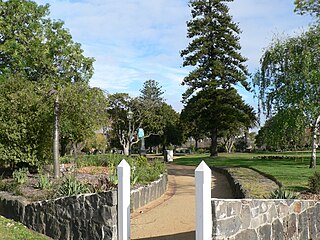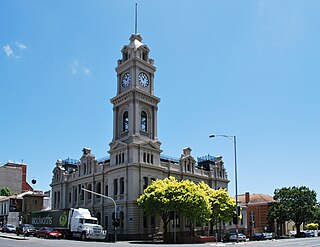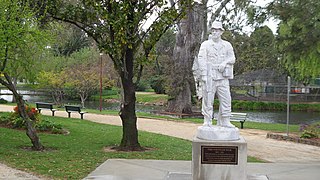
Hyde Park, Sydney, is an urban park, of 16.2-hectare (40-acre), located in the central business district of Sydney, in the City of Sydney local government area of New South Wales, Australia. It is the oldest public parkland in Australia. Hyde Park is on the eastern fringe of the Sydney city centre and is approximately rectangular in shape, being squared at the southern end and rounded at the northern end. It is bordered on the west by Elizabeth Street, on the east by College Street, on the north by St James Road and Prince Albert Road and on the south by Liverpool Street.

North Terrace is one of the four terraces that bound the central business and residential district of Adelaide, the capital city of South Australia. It runs east–west, along the northern edge of "the square mile". The western end continues on to Port Road, and the eastern end continues across the Adelaide Parklands as Botanic Road.

St Vincent Gardens in the Melbourne suburb of Albert Park, is an Australian park of national significance.

Princes Street Gardens are two adjacent public parks in the centre of Edinburgh, Scotland, lying in the shadow of Edinburgh Castle. The Gardens were created in the 1820s following the long draining of the Nor Loch and building of the New Town, beginning in the 1760s.

Market Square was a town square located in the centre of Geelong, Victoria, Australia. Consisting of eight acres of land, the area was reserved by Governor Sir George Gipps as a town square during the initial surveying of Geelong. The area later became a produce market, before being progressively built upon. Today the Market Square Shopping Centre occupies the site, having been opened in 1985 by the City of Geelong.

The Burnaby Village Museum, previously known as the Heritage Village, is an open-air museum in Burnaby, British Columbia, Canada, located at Deer Lake Park. It is open seasonally from May to September and opens for special events taking place September to March. The Burnaby Village Museum is a reconstructed 1920s village, containing 31 full scale buildings; its costumed staff demonstrate traditional trades. The museum spans 10 acres (4 ha) of land. Some of the buildings are original heritage buildings, moved from other locations in the community and restored. Others are replica buildings, created to house specific displays and artifacts, including a 1912 B.C. Electric Railway interurban tram. The museum is also known for the 1912 C. W. Parker Carousel, available for visitors to ride.

Geelong City Hall is a civic building located on Gheringhap Street in central Geelong, Victoria. It was originally built for the City of Geelong, which became the City of Greater Geelong in 1993.

Market Square Shopping Centre is located in Geelong, Victoria, Australia. The shopping centre was named after the original town square of Geelong on which the shopping centre is constructed. The centre is surrounded by Little Malop, Moorabool, Malop, and Yarra Streets. Market Square is located on the southern side of Malop Street opposite the Westfield Geelong shopping complex, the two of which together make up Geelong's Central Shopping Complex.

The Geelong Art Gallery, currently known as Geelong Gallery, is a major regional gallery in the city of Geelong in Victoria, Australia. The gallery has over 6,000 works of art in its collection. The Gallery forms Geelong's Cultural Precinct with the adjacent Geelong Library and Heritage Centre, Geelong Arts Centre, and the Geelong Courthouse.

The current Geelong Post Office opened in 1994 and is located on the corner of Gheringhap and Little Myers Streets. The original post office was located on the corner of Ryrie and Gheringhap Streets. The Geelong Telegraph Station was located next door.

The Sturt Street Gardens is a central reservation running along Sturt Street, one of the main thoroughfares of Ballarat,. The formal gardens span 13 city blocks from Grenville Street in the east to Pleasant Street in the west, are 20 metres (22 yd) wide and cover an area of 2.87 hectares running east–west.

The Geelong city centre is the urban center and main commercial locality of the Geelong metropolitan area, also referred to as the Geelong CBD, Central Geelong, the Central Activities Area, or informally simply as "Town" by locals. The name of the area is officially gazetted as Geelong.

The Saracen Foundry was the better-known name for the Possilpark, Glasgow–based foundry company W MacFarlane & Co. Ltd, founded and owned by Walter MacFarlane. MacFarlane's was the most important manufacturer of ornamental ironwork in Scotland.

The People's Park is a park located by Pery Square in Limerick, Ireland, just west of the railway station and bus terminal. At the northern edge of the park is the Limerick City Gallery of Art.

The Avenues is an area of high status Victorian housing located in the north-west of Kingston upon Hull, England. It is formed by four main tree-lined straight avenues running west off the north-north-east/south-south-west running Princes Avenue.

The city of Geelong in Victoria, Australia, operated an extensive tramway system from 1912 until 1956, when the service was replaced by buses. Unlike Victoria's other major regional cities, Ballarat and Bendigo, which have kept some track and trams as tourist attractions, no trams or tracks remain in Geelong.

The Geelong Library and Heritage Centre is a regional library, archive and resource facility in the city of Geelong, Victoria, Australia. Geelong Free Library was begun in 1858. The Geelong Historical Records Centre was established in 1979 as a depository for significant historical records and archives from the district. The centre is a Place of Deposit, as part of the Public Record Office Victoria network of community archives designated for the preservation of Victoria's history. It is described as ...the largest regional archive in Victoria.

Gympie Memorial Park is a heritage-listed memorial at River Road, Gympie, Gympie Region, Queensland, Australia. It was designed by Harry Moore and Alfred Herbert Foster and built from 1919 to 1921. It was added to the Queensland Heritage Register on 18 September 2009.

Anzac Memorial Park is a heritage-listed memorial and park at The Strand, Townsville CBD, City of Townsville, Queensland, Australia. It was first built in 1912. It is also known as The Strand Park and Townsville War Memorial. It was added to the Queensland Heritage Register on 21 October 1992.

Waring Gardens, Bandstand and Pavilion is a heritage-listed park at Cressy Street, Deniliquin, Edward River Council, New South Wales, Australia. It was designed by John Waring, the first Town Clerk of Deniliquin, and built from 1880 to 1888 by staff of the Deniliquin Council. It is also known as Cressy St Gardens.

























